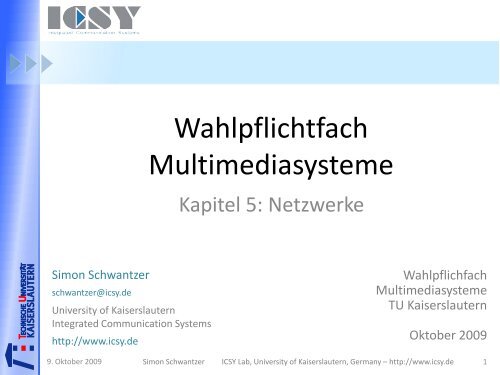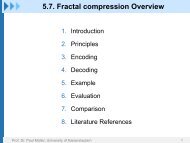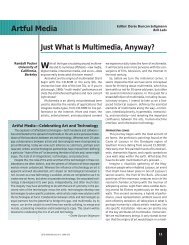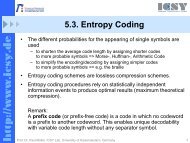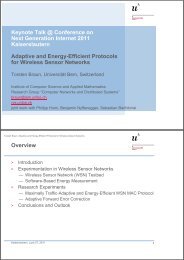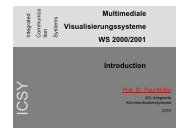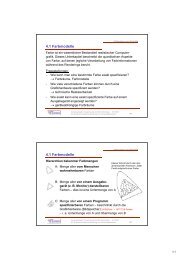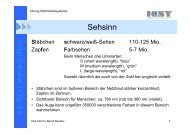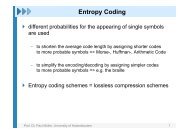Networks - ICSY
Networks - ICSY
Networks - ICSY
You also want an ePaper? Increase the reach of your titles
YUMPU automatically turns print PDFs into web optimized ePapers that Google loves.
Wahlpflichtfach<br />
Multimediasysteme<br />
Kapitel 5: Netzwerke<br />
Simon Schwantzer<br />
schwantzer@icsy.de<br />
University of Kaiserslautern<br />
Integrated Communication Systems<br />
http://www.icsy.de<br />
Wahlpflichfach<br />
Multimediasysteme<br />
TU Kaiserslautern<br />
Oktober 2009<br />
9. Oktober 2009<br />
Simon Schwantzer<br />
<strong>ICSY</strong> Lab, University of Kaiserslautern, Germany – http://www.icsy.de<br />
1
• Switching<br />
Overview<br />
• ISO/OSI Reference Model<br />
• QoS Mechanisms<br />
• <strong>Networks</strong><br />
– Ethernet<br />
– ISDN<br />
– TCP/IP<br />
– RTP<br />
October 9, 2009<br />
Simon Schwantzer<br />
<strong>ICSY</strong> Lab, University of Kaiserslautern, Germany – http://www.icsy.de<br />
2
Switching<br />
ISO / OSI Reference<br />
Model<br />
Network QoS Mechanisms<br />
ISO / OSI Reference<br />
Model<br />
SWITCHING<br />
October 9, 2009 Simon Schwantzer <strong>ICSY</strong> Lab, University of Kaiserslautern, Germany – http://www.icsy.de 3
Switching<br />
ISO / OSI Reference<br />
Model<br />
• Provide a "physical" link:<br />
connection A, B established<br />
connection C, B blocked<br />
Circuit Switching<br />
• Advantages:<br />
– guaranteed bandwidth and delay<br />
– worldwide available<br />
• Disadvantages:<br />
– bandwidth not scalable<br />
– bad efficiency (bandwidth usage)<br />
October 9, 2009<br />
Simon Schwantzer<br />
<strong>ICSY</strong> Lab, University of Kaiserslautern, Germany – http://www.icsy.de<br />
4
Switching<br />
Packet Switching<br />
• Handle independent packages:<br />
A+C sending packages of different size to B<br />
Packet may get lost because of congestion<br />
ISO / OSI Reference<br />
Model<br />
• Advantages:<br />
– high efficiency (bandwidth usage)<br />
– bandwidth is scalable<br />
• Disadvantages:<br />
– no guaranteed delay (bandwidth)<br />
October 9, 2009<br />
Simon Schwantzer<br />
<strong>ICSY</strong> Lab, University of Kaiserslautern, Germany – http://www.icsy.de<br />
5
Switching<br />
Cell Switching<br />
ISO / OSI Reference<br />
Model<br />
• Promises to combine the best of circuit switching and packet switching.<br />
All data is segmented into small cells of fixed size.<br />
Cells are multiplexed as needed.<br />
• Advantages:<br />
– high efficiency (bandwidth usage)<br />
– bandwidth is scalable<br />
– guaranteed bandwidth and delay<br />
• Disadvantages:<br />
– rare availability<br />
October 9, 2009<br />
Simon Schwantzer<br />
<strong>ICSY</strong> Lab, University of Kaiserslautern, Germany – http://www.icsy.de<br />
6
Switching<br />
ISO / OSI Reference<br />
Model<br />
QoS Mechanisms<br />
<strong>Networks</strong><br />
Switching<br />
QoS Mechanisms<br />
ISO / OSI REFERENCE<br />
MODEL<br />
October 9, 2009 Simon Schwantzer <strong>ICSY</strong> Lab, University of Kaiserslautern, Germany – http://www.icsy.de 7
Switching<br />
ISO / OSI Reference<br />
Model<br />
QoS Mechanisms<br />
ISO / OSI Reference Model<br />
October 9, 2009<br />
Simon Schwantzer<br />
<strong>ICSY</strong> Lab, University of Kaiserslautern, Germany – http://www.icsy.de<br />
8
Switching<br />
ISO / OSI Reference<br />
Model<br />
ISO / OSI (Layer 1-3)<br />
QoS Mechanisms<br />
1<br />
2<br />
3<br />
The physical layer defines electric signaling on the transmission channel;<br />
how bits are converted into electric current, light pulses or any other<br />
physical form. A serial line is an example of the physical layer. A network<br />
device for this layer is called a repeater.<br />
The data link layer defines how the network layer frames are<br />
transmitted as bits. An example of a data link layer protocol is Ethernet.<br />
A network device for this layer is called a bridge.<br />
The network layer defines how information from the transport layer is<br />
sent over networks and how different hosts are addressed. An example<br />
of a network layer protocol is the Internet Protocol. A network device<br />
for this layer is called a router.<br />
Technology<br />
(usually hardware)<br />
Protocols<br />
(usually software)<br />
October 9, 2009<br />
Simon Schwantzer<br />
<strong>ICSY</strong> Lab, University of Kaiserslautern, Germany – http://www.icsy.de<br />
9
Switching<br />
ISO / OSI Reference<br />
Model<br />
ISO / OSI (Layer 4-7)<br />
QoS Mechanisms<br />
4<br />
5<br />
The transport layer takes care of data transfer, ensuring the integrity of data if<br />
desired by the upper layers. TCP and UDP are operating at this layer.<br />
The session layer establishes and terminates connections and arranges sessions<br />
to logical parts. TCP and RPC provide some functions at this layer.<br />
6<br />
The presentation layer takes care of data type conversion. Protocols residing at<br />
this layer are used to provide interoperability between heterogeneous computer<br />
systems.<br />
7<br />
The application layer defines the protocols to be used between the application<br />
programs. Examples of protocols at this layer are protocols for WWW (http)<br />
electronic mail (e.g. SMTP) and file transfer (e.g. FTP).<br />
October 9, 2009<br />
Simon Schwantzer<br />
<strong>ICSY</strong> Lab, University of Kaiserslautern, Germany – http://www.icsy.de<br />
10
ISO / OSI Reference<br />
Model<br />
QoS Mechanisms<br />
<strong>Networks</strong><br />
Switching<br />
ISO / OSI Reference<br />
Model<br />
<strong>Networks</strong><br />
QOS MECHANISMS<br />
October 9, 2009 Simon Schwantzer <strong>ICSY</strong> Lab, University of Kaiserslautern, Germany – http://www.icsy.de 11
ISO / OSI Reference<br />
Model<br />
QoS Mechanisms<br />
<strong>Networks</strong><br />
Network QoS Mechanisms<br />
• Network Device QoS Mechanisms<br />
– Classification: type of incoming data<br />
– Shaping & Policy: keep / monitor traffic characteristic<br />
– Queueing: determine output schedule<br />
• Network Mechanisms related to QoS<br />
– Congestion control / avoidance<br />
– Routing<br />
– SLA / QoS Signaling<br />
– Media transport & usage<br />
October 9, 2009<br />
Simon Schwantzer<br />
<strong>ICSY</strong> Lab, University of Kaiserslautern, Germany – http://www.icsy.de<br />
12
ISO / OSI Reference<br />
Model<br />
QoS Mechanisms<br />
<strong>Networks</strong><br />
Traffic Classification<br />
• In order to provide QoS in a packet switched network, a network<br />
device has to classify each incoming packet<br />
– distinguish flows and aggregations (terms: flow-based vs. class-based)<br />
– Classification criteria<br />
• physical port of incoming data<br />
• frame/packet addresses (MAC, IP-Address, TCP/UDP Port-Number)<br />
• protocol interpretation<br />
– Obtaining classification info<br />
• static: by (manual) configuration<br />
• dynamic: by signaling<br />
October 9, 2009<br />
Simon Schwantzer<br />
<strong>ICSY</strong> Lab, University of Kaiserslautern, Germany – http://www.icsy.de<br />
13
ISO / OSI Reference<br />
Model<br />
QoS Mechanisms<br />
<strong>Networks</strong><br />
Shaping vs. Policing<br />
• policing: monitor the traffic characteristic, increases loss rate!<br />
• shaping: keep a traffic characteristic, increases delay!<br />
October 9, 2009<br />
Simon Schwantzer<br />
<strong>ICSY</strong> Lab, University of Kaiserslautern, Germany – http://www.icsy.de<br />
14
ISO / OSI Reference<br />
Model<br />
QoS Mechanisms<br />
<strong>Networks</strong><br />
• FIFO<br />
Packet Scheduling / Queueing<br />
– best effort service only<br />
– prior admission control<br />
and policing may<br />
improve fairness<br />
October 9, 2009 Simon Schwantzer <strong>ICSY</strong> Lab, University of Kaiserslautern, Germany – http://www.icsy.de 15
ISO / OSI Reference<br />
Model<br />
QoS Mechanisms<br />
<strong>Networks</strong><br />
Packet Scheduling / Queueing<br />
• (Strict) Priority<br />
Queueing<br />
– different services<br />
according to bandwidth<br />
and delay<br />
– unfair, because<br />
starvation of low priority<br />
flows possible<br />
October 9, 2009 Simon Schwantzer <strong>ICSY</strong> Lab, University of Kaiserslautern, Germany – http://www.icsy.de 16
ISO / OSI Reference<br />
Model<br />
QoS Mechanisms<br />
<strong>Networks</strong><br />
Packet Scheduling / Queueing<br />
• Weighted Fair Queueing<br />
(WFQ)<br />
– each queue receives a<br />
portion of the available<br />
bandwidth resources<br />
– round robin according to<br />
weight of queues,<br />
guarantees fairness<br />
October 9, 2009 Simon Schwantzer <strong>ICSY</strong> Lab, University of Kaiserslautern, Germany – http://www.icsy.de 17
ISO / OSI Reference<br />
Model<br />
QoS Mechanisms<br />
<strong>Networks</strong><br />
Isochronism<br />
An end-to-end network connection is called isochronous if<br />
the bit rate and the jitter over the connection life time is<br />
guaranteed and the jitter is small.<br />
• Isochronism therefore simply defines the requirements of<br />
continuous media streams.<br />
• Remark:<br />
– The property of media like audio and video, that must be<br />
sampled and played in regular intervals is also called isochrony.<br />
– Isochronism does not define quantitative values for jitter or<br />
probabilities refereed to by guaranteed.<br />
– If a jitter may be considered small depends on the application.<br />
October 9, 2009<br />
Simon Schwantzer<br />
<strong>ICSY</strong> Lab, University of Kaiserslautern, Germany – http://www.icsy.de<br />
18
ISO / OSI Reference<br />
Model<br />
QoS Mechanisms<br />
<strong>Networks</strong><br />
Multicasting<br />
• Multicasting is the capability to replicate data at certain internal<br />
points. Replicated data is forwarded to endsystems which are part<br />
of a multicast group.<br />
– multicast avoids or minimizes the multiple transport of the same data<br />
over the same network segments<br />
– broadcast is a special case of multicast<br />
– data duplication must be supported by forwarding engines in<br />
switches<br />
– multicast types<br />
• one-to-many unidirectional<br />
• one-to-many bi-directional<br />
• many-to-many<br />
Note: The multicast or broadcast capability on OSI layer 2 is usually a<br />
prerequisite for the realization of multicast on layer 3.<br />
October 9, 2009<br />
Simon Schwantzer<br />
<strong>ICSY</strong> Lab, University of Kaiserslautern, Germany – http://www.icsy.de<br />
19
QoS Mechanisms<br />
<strong>Networks</strong><br />
ISO / OSI Reference Model<br />
QoS Mechanisms<br />
NETWORKS<br />
October 9, 2009<br />
Simon Schwantzer<br />
<strong>ICSY</strong> Lab, University of Kaiserslautern, Germany – http://www.icsy.de<br />
20
QoS Mechanisms<br />
<strong>Networks</strong><br />
<strong>Networks</strong><br />
• Different network characteristics lead to different usability for the<br />
transport of multimedia data:<br />
– QoS guarantees:<br />
• bandwidth<br />
• delay<br />
• delay variation<br />
– Isochronism<br />
– Multicast capability<br />
– Flexibility:<br />
• bandwidth<br />
• traffic types<br />
• distance (LAN, WAN)<br />
• physical media<br />
– Efficiency/Utilization of physical media<br />
– Costs<br />
October 9, 2009<br />
Simon Schwantzer<br />
<strong>ICSY</strong> Lab, University of Kaiserslautern, Germany – http://www.icsy.de<br />
21
QoS Mechanisms<br />
<strong>Networks</strong><br />
Ethernet<br />
• History:<br />
– Xerox Corp.: R. Metcalfe (PHD at the M.I.T.) and D.<br />
Boggs<br />
– Standardized by IEEE 802.3<br />
• there are vendor specific Ethernet variants, e.g. Ethernet V2<br />
October 9, 2009<br />
Simon Schwantzer<br />
<strong>ICSY</strong> Lab, University of Kaiserslautern, Germany – http://www.icsy.de<br />
22
QoS Mechanisms<br />
<strong>Networks</strong><br />
Simon Schwantzer<br />
Ethernet<br />
• Characteristics:<br />
– Original: Bus topology<br />
– Bandwidth: 10 Mbit/s half-duplex<br />
– Several physical media: coax cable, twisted-pair, fiber<br />
– Access protocol CSMA/CD (Carrier Sense Multiple Access with<br />
Collision Detection)<br />
• Carrier sense: check if there is traffic on the net before sending<br />
• Multiple access: each station "listens" simultaneously to the net and tries to<br />
send<br />
• Collision detection: if multiple stations are sending, data will be corrupted,<br />
wait and try again<br />
⇒ demands a minimum frame size!<br />
– Evolution<br />
• Using switches, leads to star topology ⇒ CSMA/CD no longer necessary ⇒<br />
enables full-duplex<br />
• Bandwidth: 100 Mbit/s, 1 Gbit/s, 10 Gbit/s<br />
• Several extensions: auto negotiation, flow-control, burst modes, VLANtagging<br />
(IEEE 802.3Q), priorities (IEEE 802.3p), link aggregation (IEEE 802.3ad)<br />
October 9, 2009<br />
<strong>ICSY</strong> Lab, University of Kaiserslautern, Germany – http://www.icsy.de<br />
23
QoS Mechanisms<br />
<strong>Networks</strong><br />
Ethernet: Frame<br />
MAC = Medium Access Control LLC = Logical Link control<br />
SNAP = Sub-network Access Protocol DSAP = Destination Service Access Point<br />
SSAP = Source Service Access Point cntl = control<br />
org code= organization code CRC = Cyclic Redundancy Check<br />
October 9, 2009<br />
Simon Schwantzer<br />
<strong>ICSY</strong> Lab, University of Kaiserslautern, Germany – http://www.icsy.de<br />
24
QoS Mechanisms<br />
<strong>Networks</strong><br />
Ethernet: Usability for Multimedia Data<br />
• QoS parameters:<br />
– No end-to-end guarantees possible<br />
– No priorities supported<br />
• Isochronism:<br />
– not available<br />
• Multicast capability:<br />
– Multicast group addressing supported<br />
– Broadcast group addressing supported<br />
• Flexibility:<br />
– formerly fixed bandwidth of 10 Mbit/s, Ethernet derivatives up to 10 GBit/s<br />
• Efficiency:<br />
– with CSMA/CD: low throughput at high utilization because of collisions<br />
– bad efficiency for small frames because padding is required to ensure the necessary<br />
minimum frame size<br />
• Costs:<br />
– Low cost technology enables dedicate connected systems<br />
– 10/100 Mbit/s guaranteed bandwidth per host in small LANs<br />
October 9, 2009<br />
Simon Schwantzer<br />
<strong>ICSY</strong> Lab, University of Kaiserslautern, Germany – http://www.icsy.de<br />
25
QoS Mechanisms<br />
<strong>Networks</strong><br />
Integrated Services Digital Network<br />
• Standardization:<br />
– ITU recommendations (former CCITT)<br />
– ETSI and ANSI standards<br />
• Characteristics:<br />
– Public, digital, end-to-end network<br />
– Implements digital bit pipe<br />
• Based on 64 Kbit/s data rate<br />
• Multiple full duplex data channels<br />
– Support for multiple media and services within one network:<br />
• Voice, low quality video, image data, text data,<br />
• supplementary services<br />
– Common signaling channel with common set of signaling protocols<br />
• Technology:<br />
– Circuit switching<br />
– Fixed bandwidth channel assignment<br />
October 9, 2009<br />
Simon Schwantzer<br />
<strong>ICSY</strong> Lab, University of Kaiserslautern, Germany – http://www.icsy.de<br />
26
QoS Mechanisms<br />
<strong>Networks</strong><br />
ISDN: Usability for Multimedia Data<br />
• QoS parameters:<br />
– guaranteed bandwidth<br />
– low delay and low delay variation (not guaranteed, e.g. Satellite links with significantly higher<br />
delay)<br />
• Isochronism:<br />
– guaranteed by design principles<br />
• Multicast capability:<br />
– no multicast capabilities<br />
• Flexibility:<br />
– fixed bandwidth<br />
– although ISDN is used for end-to-end communications, it is mainly a WAN technology<br />
– independent of physical media<br />
• Efficiency:<br />
– low bandwidth utilization<br />
• Costs:<br />
– expensive bandwidth (Telecom ports include WAN connectivity)<br />
October 9, 2009<br />
Simon Schwantzer<br />
<strong>ICSY</strong> Lab, University of Kaiserslautern, Germany – http://www.icsy.de<br />
27
QoS Mechanisms<br />
<strong>Networks</strong><br />
Protocols (Layer 3-7)<br />
A protocol defines the rules and formats for the exchange of data.<br />
• Examples for typical protocol tasks:<br />
– Layer 3: End-to-end connectivity (host-to-host)<br />
– Layer 4: Process-to-Process connectivity<br />
– Reliable communication<br />
• Error detection<br />
• Error recovery, e.g. forward error correction or retransmission<br />
– Resource management<br />
• avoid congestion, by flow control<br />
– within the network<br />
– within end systems<br />
• Priorization<br />
• Resource reservation<br />
– Support for specialized media types<br />
• Content description<br />
• Timing / Synchronization Information<br />
– And more ...<br />
October 9, 2009<br />
Simon Schwantzer<br />
<strong>ICSY</strong> Lab, University of Kaiserslautern, Germany – http://www.icsy.de<br />
28
QoS Mechanisms<br />
<strong>Networks</strong><br />
TCP/IP Suite<br />
October 9, 2009<br />
Simon Schwantzer<br />
<strong>ICSY</strong> Lab, University of Kaiserslautern, Germany – http://www.icsy.de<br />
29
QoS Mechanisms<br />
<strong>Networks</strong><br />
Simon Schwantzer<br />
IP Protocol<br />
• Development of IP<br />
– DARPA: Defense Advanced Research Projects Agency<br />
• The research aim was to build a network that is tolerant to extensive damage, e.g. by a<br />
nuclear strike<br />
• 1973/1974 development of TCP/IP, a replacement of NCP (Network Control Protocol)<br />
• Since 1975 the ARPANET was controlled by the DoD<br />
• In the early 80'ies the military part was extracted from the ARPANET<br />
• Since 1983 exclusive use of TCP/IP, defining the term Internet<br />
– IP is specified in RFC 791<br />
– "This document is based on six earlier editions of the ARPA Internet Protocol<br />
Specification ..."<br />
• IP characteristics<br />
– Provides end-to-end communication<br />
– Connection less, i.e. state less protocol<br />
– Provides unreliable transfer of packets<br />
– Packets may be reordered during transmission<br />
– Error messages are handled by the separate protocol ICMP (Internet Control<br />
Message Protocol)<br />
October 9, 2009<br />
<strong>ICSY</strong> Lab, University of Kaiserslautern, Germany – http://www.icsy.de<br />
30
QoS Mechanisms<br />
<strong>Networks</strong><br />
IP Header<br />
Version: version of IP header<br />
IHL:<br />
TOS:<br />
IP header length in 32 bit words (5+ no. of<br />
options)<br />
Type Of Service<br />
precedence ~ priority; D,T,R if set optimize<br />
for Delay, Throughput, Reliability<br />
Flags, Frag.<br />
Offset:<br />
TTL:<br />
Protocol:<br />
used for fragmentation<br />
Time To Live, decremented by each<br />
machine to pass the packet<br />
layer 4 protocol, e.g. 1=ICMP, 6=TCP,<br />
17=UDP<br />
Length: length in bytes including the IP header Checksum: checksum for the IP header<br />
ID: serial number Options: security, record route, timestamp,<br />
source routes<br />
October 9, 2009<br />
Simon Schwantzer<br />
<strong>ICSY</strong> Lab, University of Kaiserslautern, Germany – http://www.icsy.de<br />
31
QoS Mechanisms<br />
<strong>Networks</strong><br />
• Transport protocols (Layer 4)<br />
– Provides process to process<br />
connectivity<br />
– Uses port number to identify<br />
processes. An IP address and a<br />
port number is a unique<br />
identifier for a service.<br />
• Characteristics<br />
– Closely related to IP<br />
– UDP offers a connectionless<br />
and unreliable transport<br />
service<br />
• Nearly the same service as IP<br />
• Data unit name: datagram<br />
UDP / TCP<br />
– TCP offers a connection<br />
oriented and reliable<br />
transport service<br />
• Recognition of lost data<br />
• Retransmission of lost data<br />
• Reordering of data<br />
• Delete duplicate data<br />
• Flow control<br />
– With respect to network<br />
congestion<br />
– With respect to buffer<br />
overflow at the receiver<br />
side<br />
• User data is handled as a<br />
stream of bytes<br />
– User data is split into<br />
segments<br />
• Data unit name: segment<br />
October 9, 2009 Simon Schwantzer <strong>ICSY</strong> Lab, University of Kaiserslautern, Germany – http://www.icsy.de 32
QoS Mechanisms<br />
<strong>Networks</strong><br />
TCP Flow Control<br />
• Avoid network congestion<br />
If multiple identical ACKs indicate packet loss, then slow start +<br />
congestion avoidance:<br />
October 9, 2009<br />
Simon Schwantzer<br />
<strong>ICSY</strong> Lab, University of Kaiserslautern, Germany – http://www.icsy.de<br />
33
QoS Mechanisms<br />
<strong>Networks</strong><br />
TCP Flow Control<br />
If timeout indicate packet loss, then slow start + restart slow start +<br />
congestion avoidance:<br />
October 9, 2009<br />
Simon Schwantzer<br />
<strong>ICSY</strong> Lab, University of Kaiserslautern, Germany – http://www.icsy.de<br />
34
QoS Mechanisms<br />
<strong>Networks</strong><br />
TCP Service Mechanisms<br />
• Retransmission<br />
– default: Go-back-n strategy, simple and robust mechanism but<br />
resource consuming<br />
– widely used: selective acknowledgement, retransmit lost package<br />
only<br />
– in general retransmission causes unpredictable delay<br />
• Flow control<br />
– Slow start and congestion avoidance realize considerate resource<br />
usage<br />
• enabling fair and cooperative bandwidth sharing<br />
• may cause high jitter<br />
• TCPs service mechanisms were designed for reliable data transfer<br />
TCP is not suitable for real-time communications<br />
October 9, 2009<br />
Simon Schwantzer<br />
<strong>ICSY</strong> Lab, University of Kaiserslautern, Germany – http://www.icsy.de<br />
35
QoS Mechanisms<br />
<strong>Networks</strong><br />
IPv6<br />
• Development of IPv6<br />
– 1993 the IETF called for the development of an IP next generation<br />
IPng (RFC 1550)<br />
– Improvements required<br />
• Larger address space<br />
• Reduce size of routing tables<br />
• Simplification of the protocol, to allow routers to process packets faster<br />
• Better security<br />
• Pay more attention to Type of Service<br />
• Aid multicasting<br />
• Support roaming<br />
• Easier extension of the protocol<br />
• Coexistance with the old IPv4<br />
– 1995 the IETF agreed to specification named IPv6 ( RFC1883 )<br />
• Changes to other protocols of the TCP/IP suite are specified in RFC 1884-1887<br />
October 9, 2009<br />
Simon Schwantzer<br />
<strong>ICSY</strong> Lab, University of Kaiserslautern, Germany – http://www.icsy.de<br />
36
QoS Mechanisms<br />
<strong>Networks</strong><br />
IPv6 Header<br />
Version: version of IP header<br />
Priority: 0-7 for non real time data, 8-15 for real-time data<br />
Flow Label: may be used to identify a flow, RFC 1809 discusses how the flow label<br />
could be used<br />
Payload length: length of the datagram without the header<br />
Next header: options are placed in separate extension header; next header identifies<br />
an option or the protocol above IPv6<br />
Hop limit: same as Time to Live of IPv4<br />
Addresses: • there are 7*10 23 IPv6 addresses per square meter of the world<br />
enabling well structured addresses Support of provider based<br />
addresses<br />
• and geographic based addresses<br />
October 9, 2009<br />
Simon Schwantzer<br />
<strong>ICSY</strong> Lab, University of Kaiserslautern, Germany – http://www.icsy.de<br />
37
QoS Mechanisms<br />
<strong>Networks</strong><br />
QoS in Data <strong>Networks</strong><br />
IP Service Models<br />
Traffic-Engineering<br />
Concept<br />
Network Technology<br />
Best Effort DiffServ IntServ MPLS ATM<br />
QoS<br />
Guarantees<br />
no aggregated flow based<br />
flow based and<br />
aggregated<br />
flow based and<br />
aggregated<br />
QoS<br />
Parameter<br />
no<br />
• long term<br />
• static<br />
• within a domain<br />
• per flow<br />
• dynamic<br />
• end-to-end<br />
Support for:<br />
• DiffServ<br />
• IntServ<br />
• ATM<br />
• per flow (channel) or<br />
per path<br />
• dynamic or static<br />
• end-to-end or within a<br />
domain<br />
October 9, 2009<br />
Simon Schwantzer<br />
<strong>ICSY</strong> Lab, University of Kaiserslautern, Germany – http://www.icsy.de<br />
38
QoS Mechanisms<br />
<strong>Networks</strong><br />
RTP - Real-Time Transport Protocol<br />
• Consists of two closely-linked parts:<br />
– the real-time transport protocol (RTP), carries data with real-time properties<br />
– the RTP control protocol (RTCP), monitors QoS and distributes this information to all<br />
participants of a session<br />
• RTP makes no reservations and does not guarantee any service<br />
• RTP is a protocol framework, not a complete protocol<br />
– a profile specification defines payload types and may extend RTP<br />
– a payload specification defines payload formats and encoding types must be specified<br />
– therefore RTP will typically be part of an application<br />
• The purpose of RTP is to provide additional information for real-time media<br />
streams<br />
– payload type, may change dynamically<br />
– sequence number, to determine the order (and loss) of the incoming data<br />
– timestamp, to enable synchronized and constant output of the data<br />
– contributor identifier, distinguish different contributors<br />
– ...<br />
October 9, 2009<br />
Simon Schwantzer<br />
<strong>ICSY</strong> Lab, University of Kaiserslautern, Germany – http://www.icsy.de<br />
39
QoS Mechanisms<br />
<strong>Networks</strong><br />
RTCP - RTP Control Protocol<br />
• RTP enables receiver to monitor the QoS:<br />
– Delay, jitter, PDU loss rate<br />
• RTCP periodically transmits control packets between all<br />
participants of an RTP session:<br />
– the primary function is to provide feedback about the QoS<br />
– carries transport-level identifiers for RTP sources, the canonical name<br />
(the SSRC may change over the time; the canonical name is fixed, e.g.<br />
a user name)<br />
– the rate of sent RTCP packets depends on the number of participants<br />
in order to make RTCP scalable<br />
– optionally, further information about the participants could be<br />
distributed to realize a simple session control<br />
October 9, 2009<br />
Simon Schwantzer<br />
<strong>ICSY</strong> Lab, University of Kaiserslautern, Germany – http://www.icsy.de<br />
40
Questions?<br />
Contact: Simon Schwantzer, schwantzer@informatik.uni-kl.de, http://www.icsy.de<br />
October 9, 2009 Simon Schwantzer <strong>ICSY</strong> Lab, University of Kaiserslautern, Germany – http://www.icsy.de 41
Links<br />
• Ethernet: Distributed Packet Switching for Local Computer <strong>Networks</strong><br />
http://haya.informatik.uni-kl.de:11000/diverses/Ethernet.html<br />
• Routing Basics<br />
http://www.cisco.com/en/US/docs/internetworking/technology/handbo<br />
ok/Routing-Basics.html<br />
• Size of BGB Tables<br />
http://bgp.potaroo.net/<br />
• Internetworking Technology Handbook<br />
http://www.cisco.com/univercd/cc/td/doc/cisintwk/ito_doc/<br />
• Its Latency<br />
http://www.potaroo.net/papers/isoc/2004-01/latency.html<br />
• TCP - How it works<br />
http://www.potaroo.net/papers/isoc/2004-07/tcp1.html<br />
• Visualroute<br />
http://www.webhits.de/english/index.shtml?visualroute.html<br />
October 9, 2009<br />
Simon Schwantzer<br />
<strong>ICSY</strong> Lab, University of Kaiserslautern, Germany – http://www.icsy.de<br />
42


